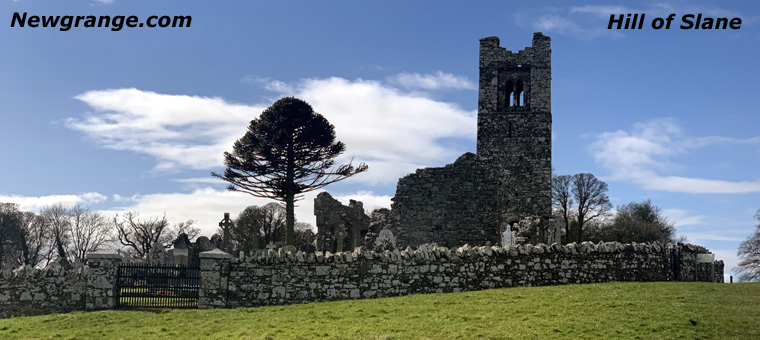Local Information
Boyne Valley Guide
 Archaeological & Historical Timeline
Archaeological & Historical TimelineTrim Heritage Town & Trim Castle,
Bective Abbey, Skryne, Ardmulchan
Hill of Tara, Navan Town
Brú na Bóinne - Newgrange & Knowth
Duleek Abbey
Battle of the Boyne
Drogheda Town
St. Peter's Church, Highlanes Gallery
Drogheda Museum, Millmount
Beaulieu House
Monasterboice
Old Mellifont Abbey
Townley Hall, Francis Ledwidge Museum
Slane Village & Slane Castle
Hill of Slane, Dowth
Donaghmore Round Tower, Donaghpatrick
Kells Town & Monastic Site
Spire of Lloyd, Patrickstown View, Oldcastle
Loughcrew Cairns
Myths & Legends
Download Boyne Valley Guide - PDF format.
Guided Tours
Brú na Bóinne Visitors Centre is the starting point for guided Tours of Knowth and Newgrange.Boyne Valley Tours - Tailored Private Driver Tours including Knowth, Newgrange, Hill of Tara, Monasterboice and other heritage sites in the County Meath and County Louth.
Accommodation
Accommodation in the Boyne Valley area.Boyne Valley
Discover Boyne Valley - Heritage sites of the Boyne Valley including guides and maps.Drogheda on the Boyne - Drogheda is one of Ireland's oldest and most historical towns and is the gateway to the Boyne Valley.
Meath Archaeological and Historical Society.
Louth Archaeological and Historical Society.
 Wonderful engravings on Kerbstone 52 at the base of the Newgrange mound.
Wonderful engravings on Kerbstone 52 at the base of the Newgrange mound.
Newgrange was built about 3,200 BC (5,200 years ago) during the Neolithic period, which makes it older than Stonehenge and the Egyptian pyramids. The mound is ringed by large stones known as kerbstones some of which are engraved with artwork.
Slane Historic Trail
There is a wealth of heritage sites in Slane and visitors to the town can follow a trail commencing at the Slane Cottages to learn more about the estate village of Slane, County Meath.Slane Cottages
The Slane cottages are situated at Canon row. Often called Cavan Row which got its name from the labourers who came from Cavan to work at the Slane Estate. Locals say it was called Lilac Lane due to the Lilac tree located at the end, now gone. These cottages were gifted to Meath County Council by Lord Henry Mount Charles in 2009.The Village Square
Slane is one of the most attractive villages in Ireland and it was the Conynghams, a military family rising to prominence at the time of William of Orange, who created this Georgian village. The centre of the village, known as the Square has four identical Georgian houses built during the 1760s on land leased to private individuals by Viscount Conyngham.Slane Castle
The building as it stands today dates from 1785 and James Wyatt, James Gandon and Francis Johnston were all commissioned by William Conyngham to assist in the design. The estate was purchased by the Conyngham family in 1701 after the lands were forfeited by the previous owners, the Fleming family in 1641, and it remains in the Conyngham family to the present day. In 1984 U2 lived in Slane Castle while recording 'The Unforgettable Fire'. Ironically, in 1991 much of the castle was severely damaged by fire, but it has been restored to its former glory by Lord Henry Mount Charles.Saint Patrick
It was on the Hill of Slane, according to ancient manuscripts, that Saint Patrick lit the Paschal Fire on Easter Eve in AD 433. St. Patrick's fire challenged the Pagan law that forbade the lighting of any other fire while the festive fire at Tara still burned. King Laoghaire was alarmed to see a fire lit on a prominent hill within sight of Tara and said that Patrick was not to be honoured in any way.Saint Erc
Erc was the only member of King Laoghaire's retinue to break ranks and pay homage to Patrick. Patrick baptised Erc and later consecrated him first Bishop of Slane. Tradition ascribes the foundation of the original monastery on the Hill of Slane to Saint Erc. In the graveyard stand two stones, the remains of a tomb of great antiquity known as Erc's Tomb. Saint Erc's foundation thrived in Slane and had an honourable history for at least six hundred years.Dagobert
Legend has it that Slane Monastery was a place of sanctity and scholarship during the quieter centuries before the arrival of the Vikings and Normans. In 653, the King of Austrasia (a kingdom in eastern Gaul) died aged 21 years leaving his two year old son Dagobert as heir. His chief ministers assumed control over the affairs of state and young Dagobert was sent to Slane Monastery to be educated. After twenty years Prince Dagobert returned home to become king.The ruins on the hill today consist of a Franciscan Church and College. They were erected by Christopher Fleming in 1512, the Fleming Family were Lords of Slane for over 500 years.
Slane Mill
The flour mill and mill-house at Slane are two of the finest examples of industrial architecture in Ireland, completed by 1766. The mill was initiated through a business transaction between William Conyngham of Slane Castle, Blayney Balfour of Townley Hall and David Jebb, an engineer for the Boyne Navigation Company.The local farmers supplied the mill with wheat and once the wheat had been milled, the flour could be transported via the Boyne Navigation to Drogheda and further on to home or foreign ports. From 1880 the mill was used as a coal depot. Towards the end of the first World War, flax scutching machinery was installed by Messers. Leitch, an Ulster firm. In the 1930s flour bag cloth was produced. The new weaving factory was opened in 1954. In 1959 a spinning mill was added. Weaving ceased in 1978, spinning in 1982 and the mill finally closed in 1983.
The Millhouse
In the early 20th century, the millhouse ceased to be used as accommodation for the managers and operated as the Boyneville Hotel, catering for tourists who enjoyed the pleasure trips operating along the canal which ran from Oldbridge to Navan from 1905 to 1914. Since 1980 it has been owned by The Quigley family from Dundalk who developed the Millhouse Hotel in 2006.Slane Historic Trail Map in PDF format
Boyne Valley Private Day Tour
 Immerse yourself in the rich heritage and culture of the Boyne Valley with our full-day private tours.
Visit Newgrange World Heritage site, explore the Hill of Slane, where Saint Patrick famously lit the Paschal fire.
Discover the Hill of Tara, the ancient seat of power for the High Kings of Ireland.
Book Now
Immerse yourself in the rich heritage and culture of the Boyne Valley with our full-day private tours.
Visit Newgrange World Heritage site, explore the Hill of Slane, where Saint Patrick famously lit the Paschal fire.
Discover the Hill of Tara, the ancient seat of power for the High Kings of Ireland.
Book Now
Home
| Newgrange
| Knowth
| Dowth
| Hill of Tara
| Fourknocks
| Loughcrew
| More Places
| Labyrinths
| Local Info
| Art Works
| Articles
| Images
| Books
| Links
| Boyne Valley Tours
| Contact

